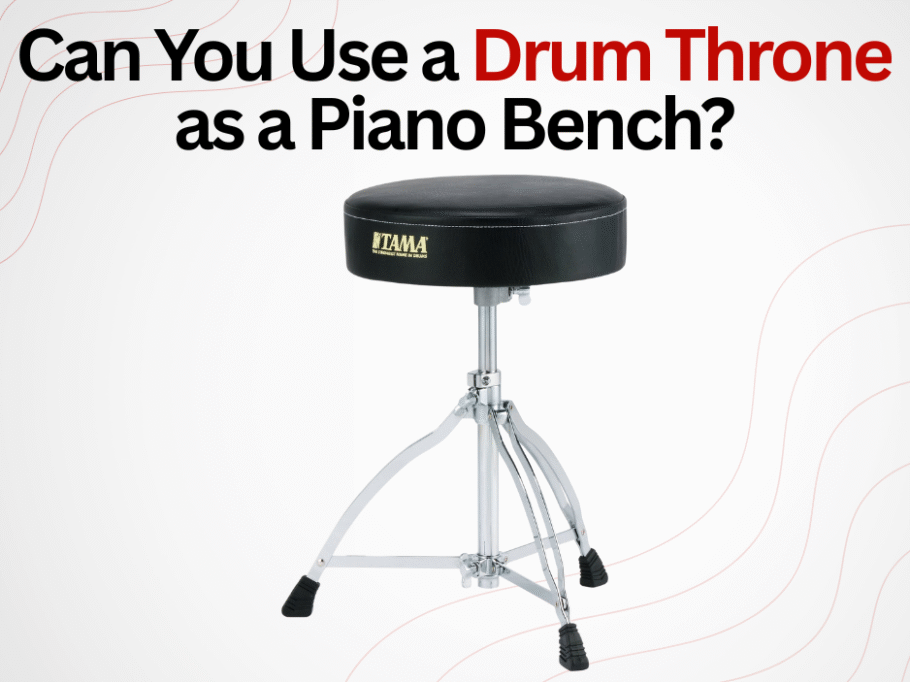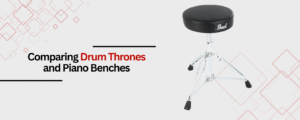Musicians often seek versatile solutions for their gear, especially when space or budget is limited. One question that arises is whether a drum throne—a staple for drummers due to its compactness and adjustability—can serve as a substitute for a traditional piano bench. While drum thrones and piano benches may appear similar at first glance, their design, ergonomics, and intended use differ significantly. This blog explores the practicality, advantages, and drawbacks of using a drum throne as a piano bench, helping musicians make an informed choice.
To know more, Read: How to Match Your Piano Bench with Your Home Decor
Comparing Drum Thrones and Piano Benches
Design and Structure:
Drum thrones are typically built with a round, padded seat mounted on a tripod base. Height adjustment is a standard feature, often allowing for quick and precise changes, which is ideal for drummers who need to modify their position frequently. Some thrones also swivel, providing additional flexibility.
Piano benches, on the other hand, are designed with a rectangular seat to accommodate the broader range of movement required at the piano. Many models, such as the Roland RPB500 or 5 Core KBB HD piano bench, offer thick cushioning, adjustable height, and a stable four-legged base. Some benches also include storage compartments for sheet music and accessories.
Ergonomics and Comfort:
Ergonomics plays a crucial role in supporting good posture and reducing fatigue during long playing sessions. Piano benches are engineered to encourage proper alignment of the back, arms, and legs, which is essential for effective technique and injury prevention. The rectangular seat allows pianists to shift side-to-side with ease, facilitating access to the full keyboard.
Drum thrones, while comfortable for drumming, may not provide the same ergonomic benefits for pianists. The smaller, round seat can restrict lateral movement, making it challenging to reach the extremes of the piano keyboard. Extended use may also lead to discomfort or strain, especially during long practice sessions.
Upgrade your practice and performance setup—choose a piano bench that delivers ergonomic comfort and reliable support.
Find the ideal piano bench for your space and playing style—explore adjustable, cushioned options built for lasting use.
Practical Considerations
Space and Portability:
Drum thrones are valued for their compact footprint and lightweight design. They are easy to transport, set up, and store, making them appealing for musicians with limited space or those who frequently move their equipment. Piano benches, especially models with storage or thick padding, tend to be bulkier and heavier.
Height Adjustability:
Both drum thrones and many modern piano benches offer adjustable height. However, the range and method of adjustment may differ. Drum thrones often use a spindle or hydraulic mechanism, while piano benches may use a knob or lever system. Finding the ideal height is essential for both comfort and proper playing technique.
Stability:
Stability is a key factor for pianists, who may shift their weight significantly while playing. Four-legged piano benches generally offer more stability than tripod-based drum thrones, reducing the risk of tipping or wobbling during energetic performances.
Advantages of Using a Drum Throne
- Portability: Drum thrones are lightweight and easy to move.
- Adjustability: Quick height changes are possible, accommodating different users or playing situations.
- Space-saving: The compact design fits well in small studios or practice rooms.
Drawbacks of Using a Drum Throne for Piano
- Limited Lateral Movement: The round seat restricts side-to-side motion, which is important for piano playing.
- Reduced Stability: Tripod bases may wobble, especially on uneven floors or during dynamic playing.
- Lack of Storage: Drum thrones do not offer compartments for sheet music or accessories.
- Potential Discomfort: Extended use may cause discomfort due to the smaller seat and lack of ergonomic support.
Customization and Multi-Use Features
The flexibility of seats is a significant feature of drum thrones that people love the most. To increase comfort, the height of most thrones can be fine-tuned, which is helpful when one is seated at different keyboards or pianos. This gives validity to the concept of alternative keyboard seating. When confined to a small space during travel, practice sessions, or when setting up a temporary studio, a singular chair that supports varying heights is very useful.
Additionally, for users who have to share their setups with family or students, the height flexibility is often more useful compared to one fixed setting on a traditional bench.
Conclusion
As the classic piano bench still keeps its place in more formal and structured settings, the exploratory use of a drum stool as a piano bench alternative is gaining some attention. From multi-purpose use to compactness, ease of sharing, and even comfort, drum thrones are providing far more than intended. Shifted demands from performers and the dissolving of traditional boundaries have made some options possible and perceivable in a different light.
During all these deliberations and movements, the names 5 Core, K&M, and Donner became discreetly prominent, each silently contributing to the evolving setup tales of musicians and their setup stories. With what the future holds is entirely unpredictable.




